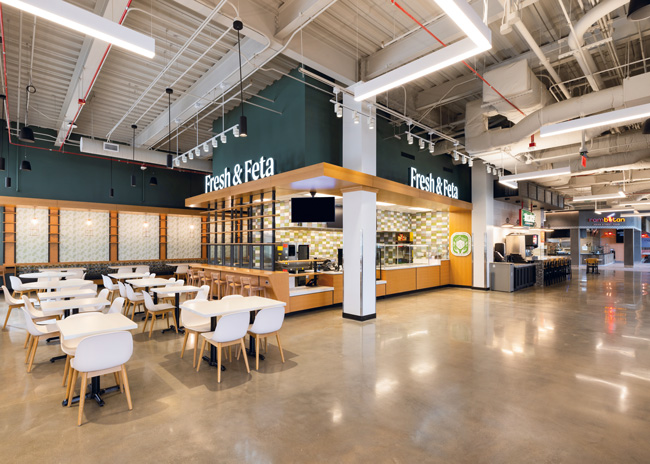After three decades in foodservice design consulting, I’ve witnessed the dramatic evolution of retail environments from simple transactional spaces to immersive brand experiences. The recently completed Perry Place at Virginia Tech’s Hitt Hall perfectly exemplifies how modern retail design principles can transform utilitarian dining into destination experiences that resonate deeply with consumers.
The Foundation: Understanding Your Audience
The most successful retail designs begin with a fundamental understanding of the end user. At Perry Place, Virginia Tech Dining Services didn’t just assume they knew what students wanted; they brought them directly into the design process. This collaborative approach, where students sat alongside designers and administrators during brand development sessions, exemplifies the first principle of effective retail design: authentic customer engagement.
The result speaks volumes. Students requested all-day breakfast, leading to the creation of Solarex Diner. They wanted Mediterranean options, inspiring Fresh & Feta. They craved authentic barbecue, birthing the wildly popular Smoke concept that consistently draws “lines a mile long” for its Texas-Kansas City hybrid barbecue offerings. When you design with rather than for your audience, authenticity becomes the natural byproduct.
Creating Cohesive Diversity
One of the most challenging aspects of multi-concept retail design is maintaining individual brand identity while ensuring overall cohesion. Perry Place masterfully achieves this balance across its nine distinct venues. Each concept from AMP Coffee’s high-energy sustainability focus to Rambutan’s exclusive Mai Pham-created Vietnamese fusion maintains its unique personality while contributing to the facility’s “understated industrial vibe.”
This approach reflects a crucial retail design principle: diversity without chaos. The architectural framework provides the unifying thread, while individual brand expressions create the memorable moments. Cooper Carry’s design team understood that students don’t want homogenization, they want authentic choices within a navigable environment.
Transparency as a Design Strategy
Modern consumers, particularly younger demographics, crave transparency in their retail experiences. Perry Place embraces this through its open-style kitchen layouts and visible cooking equipment. Students can watch their food being prepared at wok stations, observe the smoking process at the BBQ concept, and witness the care that goes into their orders.
This transparency serves multiple purposes. It reinforces freshness and quality, creates entertainment value, and builds trust between the brand and consumer. In an era where authenticity is currency, showing rather than telling becomes a powerful differentiator. The visible cooking elements, smokers, flattops, wok ranges aren’t just functional equipment; they’re theatrical props in the retail performance.
Technology Integration Without Disruption
The challenge in modern retail design lies in integrating necessary technology without compromising the human experience. Perry Place achieves this through thoughtful infrastructure planning, including raised access flooring that manages cables invisibly while accommodating multiple technology options for various operational needs.
The facility demonstrates that successful technology integration supports rather than dominates the experience. Students don’t visit Perry Place for the technology, they come for the food, atmosphere, and social experience. But the seamless tech infrastructure enables efficient operations, accurate ordering, and smooth service delivery that enhances rather than complicates their visit.
Storytelling Through Environmental Design
Every successful retail space tells a story, and Perry Place weaves Virginia Tech’s narrative throughout its design. The Solarex brand emerged from extensive research into university history, while the overall Perry Place identity draws inspiration from the historic pear orchards that once occupied the site. The logo’s pear tree motif within a shield evokes safety and comfort while honoring local legacy.
This storytelling approach creates emotional connection beyond functional satisfaction. Students aren’t just grabbing a meal; they’re participating in their university’s continuing story. The design elements from color palettes to architectural details serve as constant reminders of place and belonging.
Modular Flexibility for Operational Excellence
Retail environments must balance aesthetic appeal with operational efficiency. Perry Place achieves this through modular counter systems and flexible spatial arrangements that support both current operations and future adaptability. The centralized kitchen concept efficiently serves multiple venues while maintaining individual brand integrity at each point of service.
This modular approach reflects forward-thinking design philosophy. Student preferences evolve, menu offerings change, and operational requirements shift. Retail environments that can adapt without complete reconstruction maintain relevance and profitability over time.
Sustainability as Brand Differentiator
Modern retail design increasingly incorporates sustainability not as an afterthought but as a core brand differentiator. Perry Place integrates carbon-footprint reduction measures throughout the facility, from sustainably sourced employee uniforms printed with solvent-free inks to energy-efficient equipment specifications.
AMP Coffee specifically positions sustainability as part of its brand promise, appealing to environmentally conscious students. This approach demonstrates how sustainability can enhance rather than compromise the retail experience when thoughtfully integrated into the overall design strategy.
The Human Connection
Despite all the sophisticated design elements, successful retail environments ultimately succeed or fail based on human connection. Perry Place’s 600 seats aren’t just functional furniture, they’re carefully planned community spaces that encourage social interaction and relationship building.
The variety of seating configurations, from intimate two-tops to larger communal tables, acknowledges that retail spaces serve multiple social functions. Students need places for quick meals between classes, extended study sessions with friends, and celebratory gatherings. The environmental design supports all these scenarios.
Lessons for the Future
Perry Place at Virginia Tech offers valuable insights for retail designers across all sectors. The project demonstrates that successful retail design requires deep audience understanding, cohesive brand strategy, operational excellence, and emotional connection. Most importantly, it shows that when these elements align with authentic storytelling and sustainable practices, the result transcends mere commerce to create genuine community spaces.
As retail continues evolving in our digital age, projects like Perry Place remind us that physical spaces remain irreplaceable for human connection and authentic experience. The challenge for designers lies not in competing with digital convenience but in creating physical environments so compelling that they become destinations rather than mere transaction points.
The success of Perry Place, evidenced by its immediate popularity and consistent crowds, proves that when retail design principles are thoughtfully applied with genuine customer focus, the result is more than a facility. It becomes a beloved community institution that enhances daily life while achieving commercial success.
Photo by Darren Van Dyke, VT Dining Services




